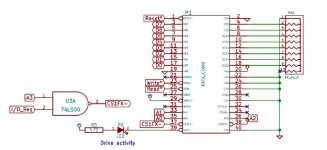MykeLawson
Experienced Member
- Joined
- Mar 21, 2014
- Messages
- 396
My development system is an STD/Z80/CPM system with 64K and uses a serial port for the console. As for storage, it has a CF to IDE adapter and uses address x8h to xFh. And since it does not decode the upper four bits of the port address, anything from 0xh to Fxh gets swallowed up. However, the software only uses the 08h to 0Fh values. So, if I add some additional decoding for the upper four bits in building out my S-100 system, things should work the same.
Now, if I added a second storage system, identical to the original, but, I added circuitry to switch between the two storage systems, I could effectively wind up with a dual boot system. I could flip bit 4 between the two and fool them into being the default.... Now, since the original is setup with a serial console and a 64K CP/M, I could take the second storage system and set it for a 62K CP/M system and put a 80x25 video card (Flashwriter II, hint, hint) in the very last 2K of the system.
When the primary storage system is active, then it disables the video card. When the secondary storage system is active, then the video card becomes active. In fact, by properly decoding the upper four bits of the I/O address, one could effectively fool the system into any number of boot configurations. And given the way my development system monitor ROM works, it could be done on the fly. Fip a switch to enable a different storage system, do a reset, and all is well. I attached the very simple schematic for the development disk system....
Now, if I added a second storage system, identical to the original, but, I added circuitry to switch between the two storage systems, I could effectively wind up with a dual boot system. I could flip bit 4 between the two and fool them into being the default.... Now, since the original is setup with a serial console and a 64K CP/M, I could take the second storage system and set it for a 62K CP/M system and put a 80x25 video card (Flashwriter II, hint, hint) in the very last 2K of the system.
When the primary storage system is active, then it disables the video card. When the secondary storage system is active, then the video card becomes active. In fact, by properly decoding the upper four bits of the I/O address, one could effectively fool the system into any number of boot configurations. And given the way my development system monitor ROM works, it could be done on the fly. Fip a switch to enable a different storage system, do a reset, and all is well. I attached the very simple schematic for the development disk system....

